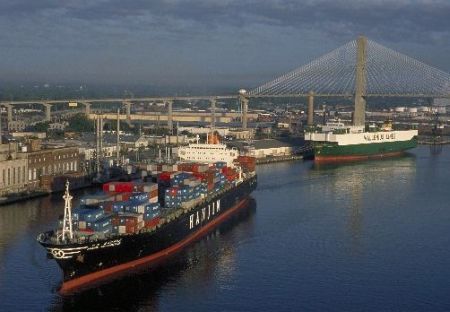
The Georgia Ports Authority (GPA) has received final approval for its harbour deepening, which will allow the Port of Savannah to more efficiently serve Post-Panamax vessels and lower shipping costs for containerised trade by $213 million a year.
Assistant Secretary of the U.S. Army (Civil Works) Jo-Ellen Darcy issued the Record of Decision Oct. 26, approving the Savannah Harbor Expansion Project (SHEP).
“The Record of Decision affirms that this is a project of national significance,” said GPA Executive Director Curtis Foltz. “It is a major milestone culminating what has been a 15-year effort. It is proof once again this port is going to deliver.”
Corps of Engineers studies show that Post-Panamax vessels more efficiently served by a deeper harbour in Savannah will lower shipping costs for containerised trade by $213 million a year over the next 50 years, for a total economic benefit of $10.65 billion during that span. Decreased costs per container will lower the bottom line for the more than 21,000 U.S. businesses, and thousands of international businesses shipping via the Port of Savannah.
The Record of Decision demonstrates that deepening the Savannah harbour to 47 feet is economically viable, environmentally sustainable, and in the best interests of national and international trade.
“The project delivers tremendous value to the supply chain,” Foltz said. “That is why it is so strongly supported by the United States government.”
The planned new depth of 47 feet strengthens the Port of Savannah’s position as a major global trade destination, allowing it to more efficiently accommodate Post-Panamax containerships. Additionally, general navigation will be improved, with wider channel turns and a larger turning basin. The Savannah River, which features a seven-foot tidal change twice a day, will continue to host two-way containership traffic.
“Ships such as the 9200-TEU MSC Roma already call on the Port of Savannah via the Suez Canal,” said GPA Chairman Robert Jepson. “The Panama Canal expansion is expected to increase the number of these ships calling on the U.S. East Coast, so it is vital that our ports prepare for these and larger vessels.”
Scheduled for completion in 2015, the Panama Canal expansion will increase the maximum possible draft of vessels traveling to and from the U.S. East Coast via Panama from 39.5 feet to as much as 50 feet.
The State of Georgia has already committed $181.1 million to the SHEP, which is expected to cost a total of $652 million. Now that a Record of Decision has been issued, federal construction funds can be appropriated to move the project forward.
The Administration’s approval for SHEP comes after 16 years of study and unprecedented collaboration between GPA, U.S. Environmental Protection Agency, the U.S. Fish and Wildlife Service, the National Marine Fisheries Service, and other federal and state agencies, as well as non-governmental stakeholders, to identify and address all concerns. The deepening project will be carried out with full consideration of the local population, wildlife and environment.
“SHEP, in combination with our improved landside infrastructure, further strengthens our position as a Southeast gateway,” Foltz said. “The road and rail access will serve this industry’s needs well into the future.”
The Port of Savannah is the fourth busiest port in the U.S. It benefits from the largest continuous campus of any port in the country, and the forthcoming deepening strengthens its position as a major destination in global transportation and logistics. The Port of Savannah is served by two Class I rail providers, Norfolk Southern and CSX, via on-terminal rail facilities with no weight restrictions. The Port of Savannah is closest and fastest by rail to the major population centers of Atlanta, Birmingham, Charlotte, Memphis and Orlando. Immediate access to I-16 (East/West) and I-95 (North/South), means key cities and manufacturing points throughout the U.S. Southeast and Midwest may be reached within a one- to two-day drive.
The Port of Savannah was the second busiest U.S. container port for the export of American goods by tonnage in FY2011. It also handled 8.1 percent of the U.S. containerised cargo volume and 11.6 percent of all U.S. containerised exports in FY2011.
Georgia’s deepwater ports and inland barge terminals support more than 352,000 jobs throughout the state annually and contribute $18.5 billion in income, $66.9 billion in revenue and $2.5 billion in state and local taxes to Georgia’s economy.
We use cookies to improve your experience. By continuing to use our site, you accept our Cookies, Privacy Policy,Terms and Conditions. Close X